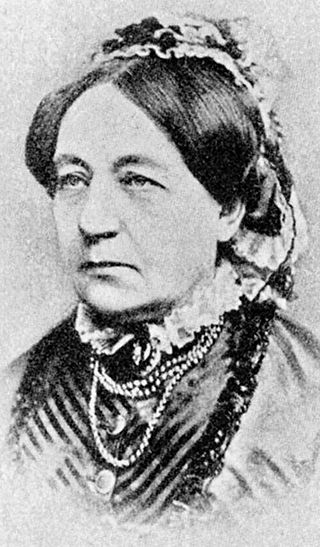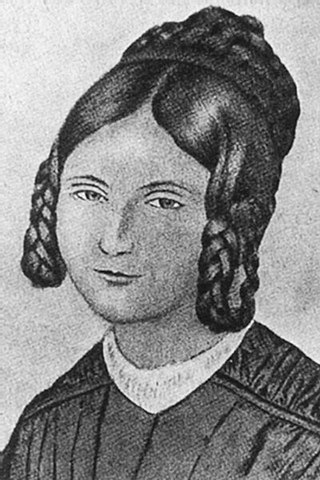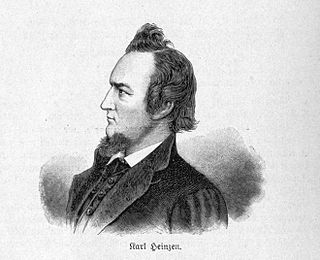
Carl Schurz was a German revolutionary and an American statesman, journalist, and reformer. He migrated to the United States after the German revolutions of 1848–1849 and became a prominent member of the new Republican Party. After serving as a Union general in the American Civil War, he helped found the short-lived Liberal Republican Party and became a prominent advocate of civil service reform. Schurz represented Missouri in the United States Senate and was the 13th United States Secretary of the Interior.

The Milwaukee Journal Sentinel is a daily morning broadsheet printed in Milwaukee, Wisconsin, where it is the primary newspaper and also the largest newspaper in the state of Wisconsin, where it is widely read. It was purchased by the Gannett Company in 2016.

The Allgemeine Zeitung was the leading political daily journal in Germany in the first part of the 19th century. It has been widely recognised as the first world-class German journal and a symbol of the German press abroad.
Gertrud Bäumer was a German politician who actively participated in the German civil rights feminist movement. She was also a writer, and contributed to Friedrich Naumann's paper Die Hilfe. From 1898, Bäumer lived and worked together with the German feminist and politician Helene Lange.
The 34th Wisconsin Infantry Regiment was a conscripted infantry regiment that served in the Union Army during the American Civil War.
Schadeleben is a village and a former municipality in the district of Salzlandkreis, in Saxony-Anhalt, Germany. Since 15 July 2009, it is part of the town Seeland.

Louise Otto-Peters was a German suffragist and women's rights movement activist who wrote novels, poetry, essays, and libretti. She wrote for Der Wandelstern [The Wandering Star] and Sächsische Vaterlandsblätter [Saxon Fatherland Pages], and founded Frauen-Zeitung and Neue Bahnen specifically for women. She is best known as the founder in 1865 of the General German Women's Association.

Mathilde Franziska Anneke was a German writer, feminist, and radical democrat who participated in the Revolutions of 1848–1849. In late 1849, she moved to the United States, where she campaigned to end slavery, agitated to enfranchise women, and ran a girls' school.

Franziska Freifrauvon Reitzenstein was a German novelist.

The Kölner Stadt-Anzeiger (KStA) is a German daily newspaper published in Cologne, and has the largest circulation in the Cologne–Bonn Metropolitan Region. Kölner Stadt-Anzeiger has a base of over 100 contributing editors and a wide network of correspondents for local and regional news reporting.

Karl Peter Heinzen was a revolutionary author who resided mainly in Germany and the United States. He was one of the German Forty-Eighters. He advocated terrorist violence against ruling dynasties and uninvolved civilian populations as a means to an end.

Karl Friedrich Theodor "Fritz" Anneke was a German revolutionary, socialist and newspaper editor. He emigrated to the United States with his family in 1849 and became a Union Army officer in the American Civil War, and later worked as an entrepreneur and journalist. He was the husband of Mathilde Franziska Anneke, the older brother of Emil Anneke, the first Republican Michigan Auditor General, and the father of Percy Shelley Anneke, well known in Duluth, Minnesota, as co-founder and owner of the famous Fitger Brewing Company.

Joseph Arnold Weydemeyer was a military officer in the Kingdom of Prussia and the United States as well as a journalist, politician and Marxist revolutionary.

The Lily was the first U.S. newspaper edited by and for women. It was published from 1849 to 1853 by Amelia Jenks Bloomer (1818–1894) before she sold the newspaper to Mary Birdsall in 1854. While the newspaper initially focused on temperance, it soon broadened its focus to include the many issues of women's rights activists in the 1850s. It grew in its distribution as a result of its discussion of bloomers, a comfortable fashion popularized by Bloomer in the paper.

The socio-political movements and ideologies of feminism have found expression in various media. These media include newspaper, literature, radio, television, social media, film, and video games. They have been essential to the success of many feminist movements.

Attempts to secure women's suffrage in Wisconsin began before the Civil War. In 1846, the first state constitutional convention delegates for Wisconsin discussed women's suffrage and the final document eventually included a number of progressive measures. This constitution was rejected and a more conservative document was eventually adopted. Wisconsin newspapers supported women's suffrage and Mathilde Franziska Anneke published the German language women's rights newspaper, Die Deutsche Frauen-Zeitung, in Milwaukee in 1852. Before the war, many women's rights petitions were circulated and there was tentative work in forming suffrage organizations. After the Civil War, the first women's suffrage conference held in Wisconsin took place in October 1867 in Janesville. That year, a women's suffrage amendment passed in the state legislature and waited to pass the second year. However, in 1868 the bill did not pass again. The Wisconsin Woman Suffrage Association (WWSA) was reformed in 1869 and by the next year, there were several chapters arranged throughout Wisconsin. In 1884, suffragists won a brief victory when the state legislature passed a law to allow women to vote in elections on school-related issues. On the first voting day for women in 1887, the state Attorney General made it more difficult for women to vote and confusion about the law led to court challenges. Eventually, it was decided that without separate ballots, women could not be allowed to vote. Women would not vote again in Wisconsin until 1902 after separate school-related ballots were created. In the 1900s, state suffragists organized and continued to petition the Wisconsin legislature on women's suffrage. By 1911, two women's suffrage groups operated in the state: WWSA and the Political Equality League (PEL). A voter referendum went to the public in 1912. Both WWSA and PEL campaigned hard for women's equal suffrage rights. Despite the work put in by the suffragists, the measure failed to pass. PEL and WWSA merged again in 1913 and women continued their education work and lobbying. By 1915, the National Woman's Party also had chapters in Wisconsin and several prominent suffragists joined their ranks. The National Woman Suffrage Association (NAWSA) was also very present in Wisconsin suffrage efforts. Carrie Chapman Catt worked hard to keep Wisconsin suffragists on the path of supporting a federal woman's suffrage amendment. When the Nineteenth Amendment went out to the states for ratification, Wisconsin an hour behind Illinois on June 10, 1919. However, Wisconsin was the first to turn in the ratification paperwork to the State Department.

This is a timeline of women's suffrage in Wisconsin. Women's suffrage efforts began before the Civil War. The first Wisconsin state constitutional convention in 1846 discussed both women's suffrage and African-American suffrage. In the end, a more conservative constitution was adopted by Wisconsin. In the 1850s, a German language women's rights newspaper was founded in Milwaukee and many suffragists spoke throughout the state. The first state suffrage convention was held in Janesville in 1867. The 1870s, several women's suffrage groups were founded in the state. In 1884, a women's suffrage bill, allowing women to vote for school-related issues is passed. In 1886, voters approve the school-related suffrage bill in a referendum. The first year women vote, 1887, there are challenges to the law that go on until Wisconsin women are allowed to vote again for school issues in 1902 using separate ballots. In the 1900s, women's suffrage conventions continue to take place throughout the state. Women collect petitions and continue to lobby the state legislature. In 1911 Wisconsin legislature passes a bill for women's suffrage that will go out to the voters in 1912. On November 4, 1912 voters disapprove of women's suffrage. Women's suffrage efforts continue, including sponsoring a suffrage school and with the inclusion of a National Woman's Party (NWP) chapter formed in 1915. When the Nineteenth Amendment goes out to the states, Wisconsin ratifies on June 10 and turns in the ratification paperwork first, on June 13, 1919.

Mary Humphrey Corss Booth was an American poet and abolitionist. She published the collection Wayside Blossoms Among Flowers from German Gardens (1865).















